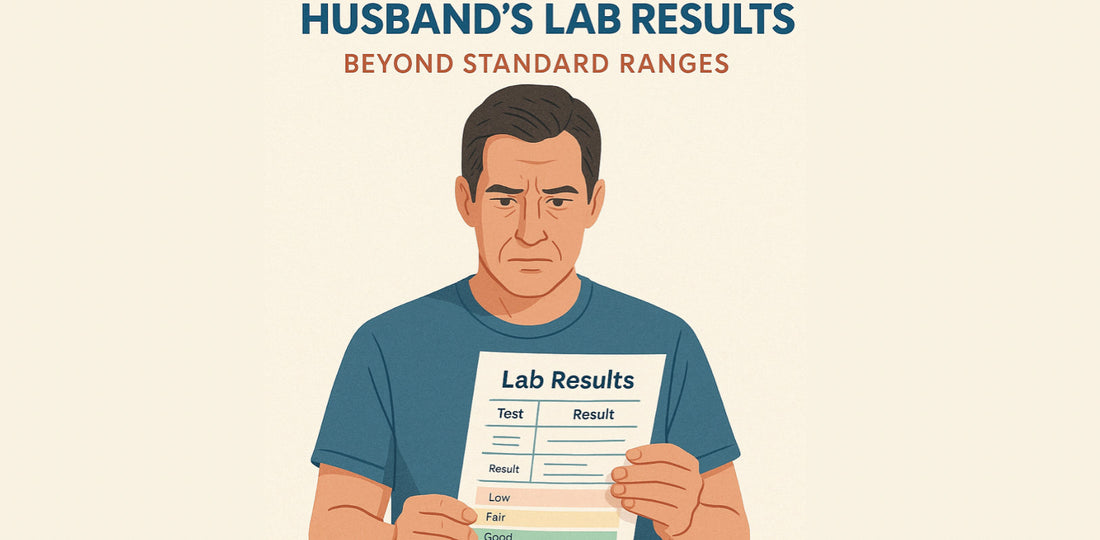
Understanding Your Husband’s Lab Results: Beyond Standard Ranges
By Bryce WyldeYou’ve booked the appointment. He’s had the blood draw. Now the results are in and you’re staring at a wall of numbers. Maybe everything is marked “normal,” but he’s still tired. Maybe he’s short-tempered, sluggish, or can’t drop weight no matter what he tries. You know something’s off, but the lab report tells you otherwise. This is why standard ranges aren’t enough and why HUSBAND takes a different, more precise approach powered by SiPhox lab tech.
What It Is: Clinical Optimization vs. Standard Reference Ranges
Every lab result you receive shows a “reference range.” This is the traditional way to assess whether a marker is “normal.” But what’s normal for the average population isn’t the same as what’s ideal for your man’s energy, longevity, and healthspan.
At HUSBAND, we go beyond “normal” with our proprietary HUSBAND Grades which are a clinically validated framework for assessing biomarkers based on outcome-based science, not statistical averages. It’s how we turn raw data into actionable insight.
Why It Matters for Men 40+
As men age, subtle shifts in hormones, inflammation, and metabolism can quietly chip away at vitality long before a disease diagnosis shows up. His labs might be “in range,” but that doesn’t mean he’s thriving.
That’s where optimization matters. A cortisol level that’s “normal” could still be causing poor sleep. A testosterone level “within range” might be robbing him of drive and confidence. Our approach is built for early detection and high performance—not just disease prevention.
What the Research Says
-
Reference ranges are based on the 95% bell curve of the local population—which includes people with chronic illness. They are meant to catch illness, not guide optimal living.
-
Optimization ranges are based on peer-reviewed literature linking biomarkers with actual health outcomes—like cardiovascular health, cognitive clarity, and hormonal resilience.
-
Studies show that even within “normal” ranges, lower or higher values of markers like vitamin D, testosterone, or hsCRP are linked with dramatically different risks of fatigue, heart disease, depression, and more.
-
The SiPhox-powered Mega Panel lets us analyze over 30 essential biomarkers with precision—many of which aren’t included in your typical annual checkup.
Why HUSBAND Includes It
At HUSBAND, we use a SiPhox-powered panel that captures over 30 biomarkers that matter most for men over 40. Each one is interpreted using our HUSBAND Grading System, designed to help you act early—before symptoms turn into conditions. Here's what we test, and why:
-
HDL / LDL / Triglycerides / VLDL / Total Cholesterol – The full lipid picture. Beyond “bad” and “good” cholesterol, ratios like LDL:HDL and ApoB:ApoA tell the real story of cardiovascular risk.
-
ApoA / ApoB / Lipoprotein(a) – Apolipoproteins are better predictors of heart risk than cholesterol alone. Lp(a) is genetic and rarely tested, but high levels can triple heart attack risk.
-
TSH / Free T3 / Free T4 / TPO – Thyroid hormones affect metabolism, energy, and mood. Suboptimal levels—even if “normal”—can cause brain fog, weight gain, and fatigue.
-
HbA1c / Glucose / EAG / HOMA-IR / Insulin – A deep look into blood sugar regulation and insulin resistance. Critical for understanding hidden prediabetes or metabolic slowdown.
-
Cortisol – The stress hormone. Chronic elevations or flat rhythms can affect sleep, belly fat, libido, and immune health.
-
Vitamin-D – Essential for immune function, testosterone production, and mood. Our optimal range (40–70 ng/mL) is based on real-world health outcomes.
-
Testosterone Total / Free Testosterone / SHBG / FAI – Total testosterone doesn’t tell the whole story. We test for bioavailable forms and hormone-binding proteins to assess true androgen health.
-
DHEA-s – A marker of adrenal vitality and resilience, supporting mood, libido, and aging.
-
Estradiol / FSH / LH / Prolactin – These hormones help explain root causes of testosterone imbalance, libido changes, and mood fluctuations.
-
Ferritin – Not just about anemia—too much or too little can impact energy, inflammation, and performance.
-
Homocysteine – An inflammatory marker tied to heart, brain, and vascular health.
-
hsCRP – A high-sensitivity marker of systemic inflammation. Early warning for chronic disease.
-
ALT / AST / Albumin / Bilirubin – A full view of liver function and detoxification capacity.
-
BUN / Creatinine / eGFR – Markers of kidney health and metabolic waste clearance.
-
PSA – Prostate-specific antigen. Important baseline for monitoring prostate health as men age.
What to Expect
-
Pay Attention: Still “normal” by lab standards but flagged as needing action
-
Fair: Slightly off from optimal, worth tuning up
-
Good: Better than average, strong baseline
-
Optimal: Dialed-in and on track for healthspan
This grading lets you see not just where he is—but where he could be.
What Experts Say
“Most labs are built to catch disease once it’s already there. At HUSBAND, we’re trying to prevent it. That means using scientific evidence to set targets that help men thrive—physically, mentally, and emotionally.”
— Bryce Wylde, Functional Medicine Clinician and CEO, HUSBAND

